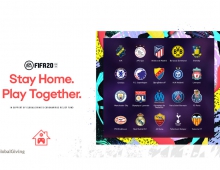
EA Announces Project Atlas Cloud Gaming Service
Following the current trend to bring gaming streaming the masses, EA announced a new cloud gaming development platform called 'Project Atlas' as it eyes a video game streaming future.
Announced by Ken Moss, Chief Technology Officer at Electronic Arts, 'Project Atlas' will bring together "some of the most transformative technologies into an integrated engine + services game development platform." The platform will be designed from the core to harness the power of cloud computing and artificial intelligence.
A game engine is what controls the "fundamentals" of the game with things like rendering, game logic, physics, animation, audio, and a toolchain for creating the game. And a rich set of services like secure player identity and authentication, player matchmaking and achievements, and social communications with friends bring the game to life.
Moss said that 'Project Atlas,' powered by a global network of servers, will enable "deeper personalization, and will eventually create a world full of user generated content, blurring the lines between the discrete domains of game engines and game services."
Leveraging Artificial Intelligence will allow developers to use it to optimize almost any element of a game - from the distribution of resources in an online shooter, to populating and evolving expansive virtual worlds with minimal manual intervention, to unlocking deep personalization of in-game agents at scale.
AI and machine learning will also give game makers the ability to craft in-game interactions with non-playable characters or NPCs in a way that is virtually indecipherable from a human interaction. So, instead of a pre-scripted, pattern-based logic for NPC behavior, this would make it possible for an NPC to engage in a way that is dynamic, contextual and believable.
"For example, imagine that you’re playing Madden, and you’ve just thrown your second interception of the game against the same cover 2 defense that caused the first turnover. Instead of the commentator simply stating that you threw a pick, the AI enables contextual, real-time commentary to reference the fact that you’re throwing to the sideline against a cover 2 defense and should have thrown against the weak zone over the middle to your tight end, who was open on the route. This would certainly push the game into a greater level of contextual and experiential realism. The AI is working with your gameplay. It’s responding to your needs as a player," Moss explained.
EA wants to integrate all of this new functionality, directly into the Project Atlas. The platform is designed to converge EA’s Frostbite game engine and game services as well as artificial intelligence. While in the past, features like cloud hosting, matchmaking, marketplace, data, AI, achievements, and social were separate from the development tools in the engine, the Project Atlas platform will be able to implement all of these services natively within a unified solution.
Moss says that we already see Project Atlas in action, though seen some technological advances recently, for example:
- Low resolution standard dynamic range to Ultra HD high dynamic range.
- 4G and WiGig connectivity to 5G in the future.
- A plethora of 3D graphics innovations in lighting, texturing, and drawing objects.
- Big data, server-side neural network algorithm training, with client-side inferencing.
With Project Atlas, EA wants to put the power of AI in the creative’s hands. In one example, the company is using high-quality LIDAR data about real mountain ranges, passing that data through a deep neural network trained to create terrain-building algorithms, and then creating an algorithm which will be available within the platform’s development toolbox. With this AI-assisted terrain generation, designers will within seconds generate not just a single mountain, but a series of mountains and all the surrounding environment with the realism of the real-world.
With Project Atlas, EA is now working to optimize cloud distribution of engine services to process the rendering, physics, and simulation of a game instead of being entirely constrained to the specs of a single client-side computing device.
In typical multi-player games today, game performance is a balancing act of the demands of different resources and quality constraints — memory, CPU, GPU, fidelity, resolution, and framerate. Today, the balancing act of all those different constraints generally tops out at about 100 players competing at the same time on a map of a few dozen square kilometers. But the cloud starts to erase those limitations. Thousands of players could compete on a single map hundreds or thousands of kilometers wide, in a game session that could last for days, weeks, or years and with the progression and persistence of realistic seasons and campaigns.
Enabling the engine to run on the cloud also means EA could evolve collaborative tools that are core to the actual design process. Previously, it was easiest when only one developer was working on a map at a time to avoid forcing a difficult merge with another developers changes. But with the right design of the engine, multiple designers could share that map and enable simultaneous updates in a collaborative and creative environment.
EA also wants to more easily and safely open up powerful avenues for players to create within games and services.
"You can dream, turn your own vision into reality, and share your creation with your friends or the whole world. You can potentially even market your ideas and visions to the community. To unlock that potential, you need a cloud-enabled engine that seamlessly integrates services. You need an accessible build of the game and a moddable asset database. You need a common marketplace for sharing and rating player creations. All that doesn’t exist yet today, but this is exactly what we are working towards with Project Atlas," Moss said.
Regarding privacy, with the Project Atlas game makers will have the ability to deploy security measures including SSL certificates, configuration, appropriate encryption of data, and zero-downtime patches for every feature from a single secure source.
EA isn't ready to reveal a launch date just yet.
The cloud-gaming battle is coming, and Besides EA, Microsoft and Google have already started work on their respective video game streaming projects.
Google’s Project Stream this month began letting U.S. users play the latest version of Assassin’s Creed on a Chrome browser from any computer. Amazon.com, which bought gameplay-streaming website Twitch and has the No. 1 cloud-computing service, is in a prime position to push into cloud gaming.
From next year, Microsoft's Project xCloud will use the company’s global cloud network Azure to stream and play high-end games, on "any device." Early impressions of Google’s Project Stream have been favorable, with users saying that the experience comes close to playing on a console or personal computer - without the need to actually own one.
It is not clear whether whether PS4’s successor will be designed to embrace cloud gaming, include handheld gaming, move deeper into virtual and augmented reality — or all of the above. Sony has yet to set a date for what will presumably be called the PlayStation 5.





















